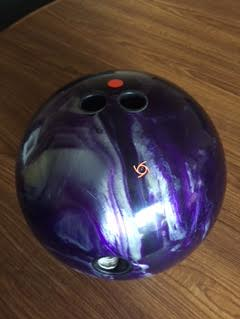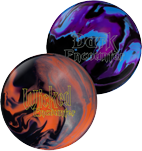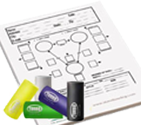The original FIGHT was all around a
brand new development in Storm’s Thunder Line.
It combined an unusually large core (Iron CrossTM)
with a new R4S solid reactive coverstock.
The size of the core creates an RG at the upper
end of the spectrum (2.62) with a moderate diff (0.043)
at 15lb.
Many have thought the FIGHT a bad
ball because it isn’t the big booming backend ball that
so many people want these days.
It’s a niche ball – perfect for the tournament
player on medium volume and medium length patters
(sometimes shorter and lighter volume as well) when
keeping launch angles closed and controlling backend
motion is key.
The STREET FIGHT is similar, though more
versatile. The
downside to the original FIGHT for me was that in situations
when it was the perfect tool, its usefulness was not
long-lived.
When lane transition required moving out of an initial “tube
style” of lane play, the FIGHT oftentimes didn’t provide
enough down lane recovery for me on shots sent wide of
target or shots missed at the bottom just a little.
The STREET FIGHT is wrapped with an R4S Pearl
Reactive cover that provides more pop on the backend than
the R4S solid cover on the FIGHT does.
For me, that has made its usefulness a little more
expansive especially in typical league play around the STL.
Whereas the FIGHT was great for going up the track at
the outset of league but usually had to be put away by the
middle of the second game, the STREET FIGHT can go the
three-game distance as lanes transition.
The layout on mine is the
same as my FIGHT, a pretty standard pin over the bridge
layout for me.
The specs come to 55 x 5.5 x 45.
On hooking STL house patterns the STREET FIGHT has
produced a handful of 750+ sets for me.
Not having bowled on any tougher patterns lately, I
can’t speak to how it would handle them.
Judging from what I have seen, though, I would be
very surprised if it doesn’t end up being a very effective
tool to have along for medium volume and medium length
patterns. Too
much volume and too much length in the pattern would not be
a good combination (for me anyway) with this ball’s very
high RG. I
would end up missing the break point most of the time.
I’d say the same might be true for higher speed
players or bowlers with lesser hand even on regular house
shots.
Recently, a friend who is a
solid bowler and who prefers a “down and in” approach to
things so much that he bowls most of the time with urethane,
plastic, or some sort of an antique resin ball decided to
try a STREET FIGHT.
During his first practice session he sent me a series
of texts lamenting the fact that he couldn’t get a hook with
it. His eye was
used to seeing urethane/plastic hook early/stop ball motion
going straight up the dry outside of 10-board on a high
friction surface.
Once reminded that this ball isn’t your typical
reactive resin ball – which always translates for this
friend into a mindset of having to “shoot the ball through
the heads” in order to get it to stay on line in his
down-and-in approach to things – he started focusing on
really getting it into a roll off his hand and he began to
see the STREET FIGHT’s true potential come through.
I have very much enjoyed using the STREET FIGHT in league so
far this fall. While
maybe not the perfect choice all the time, I have often
stuck with it because using it forces me to keep my release
from getting lazy (a peril I suffer bowling a regular diet
of house shot bowling with more forgiving equipment).
Even though it provides a little more backend motion
than the FIGHT, a miss at the bottom will still translate
into a flat ten most of the time.
That’s a good thing in my book….for a bowler who
wants to be forced to execute well in order to strike.
It has helped turn league sessions into an occasion
for staying sharp, which is never a bad thing in my book







